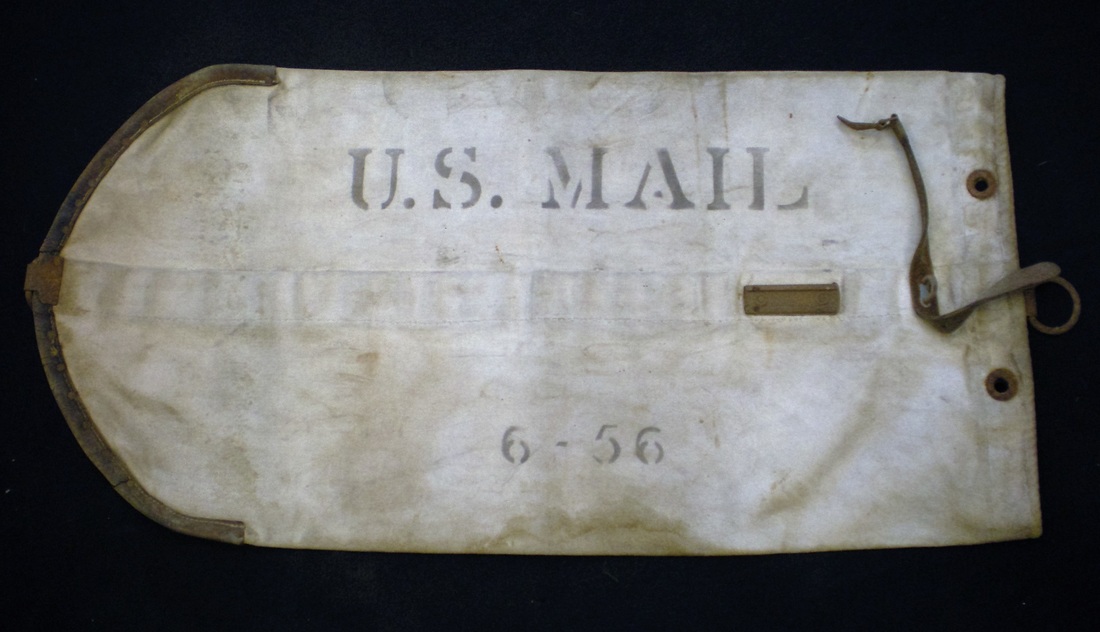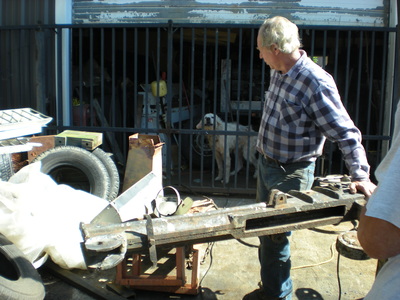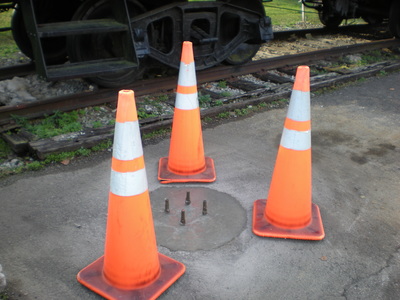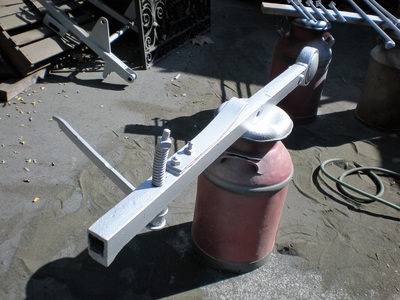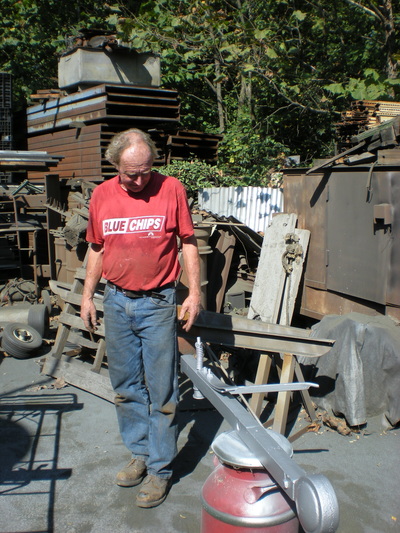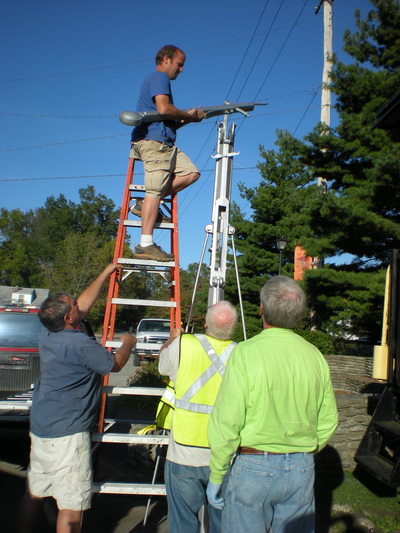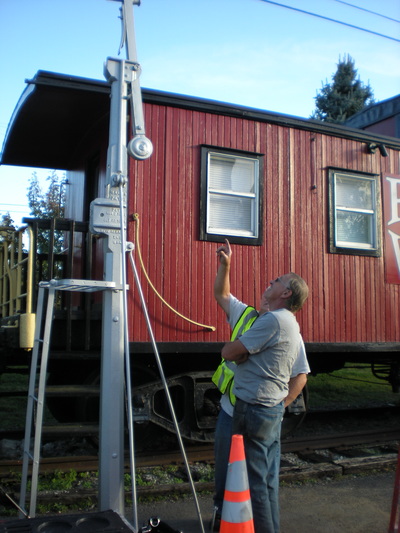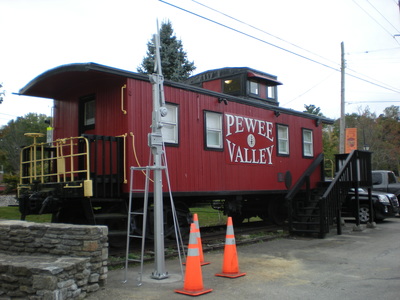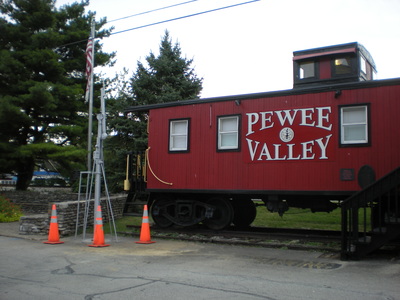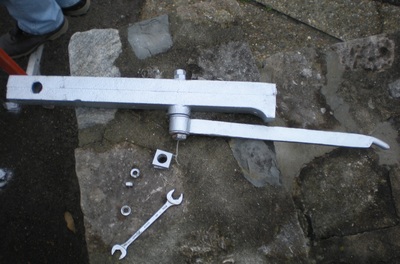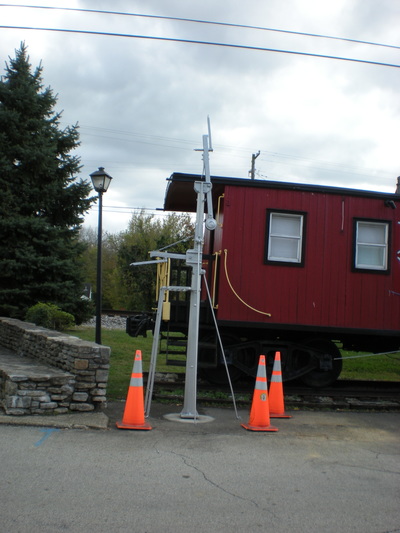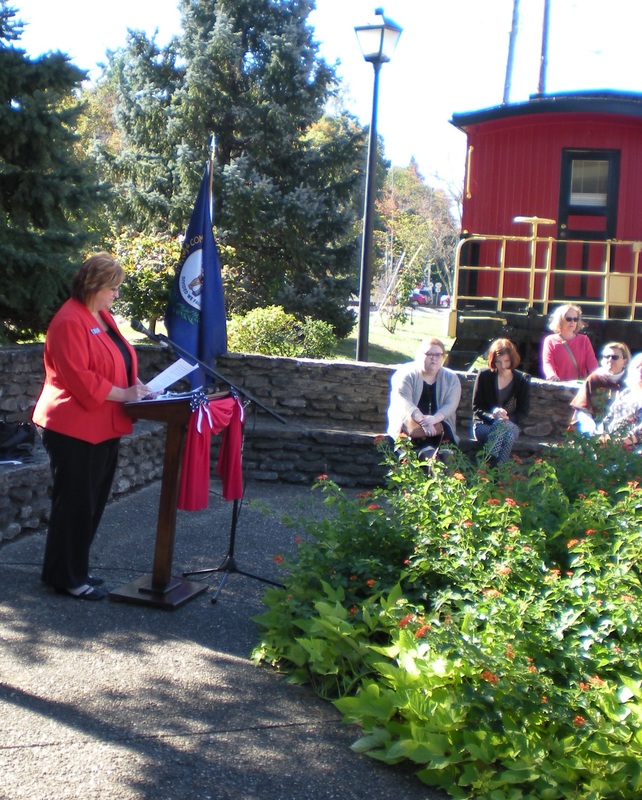Mail by Rail

Above, Pewee Valley's mail crane loaded with a catcher pouch of outgoing mail minutes before the train arrives. Below, the railroad post office car with its mail-bag catcher arm extended just after the clerks snatched the mail from the crane. Both photos from Katie S. Smith's 1974 publication, "Pewee Valley: Land of the Little Colonel."
Just like on the CBS TV sitcom, “Petticoat Junction,” which aired from 1963-1970, trains delivered Pewee Valley’s mail for more than a century, starting in 1856, when the town’s first post office was established. And for many years, the post office was located in a grocery store, similar to Sam Drucker’s general store in the popular series.
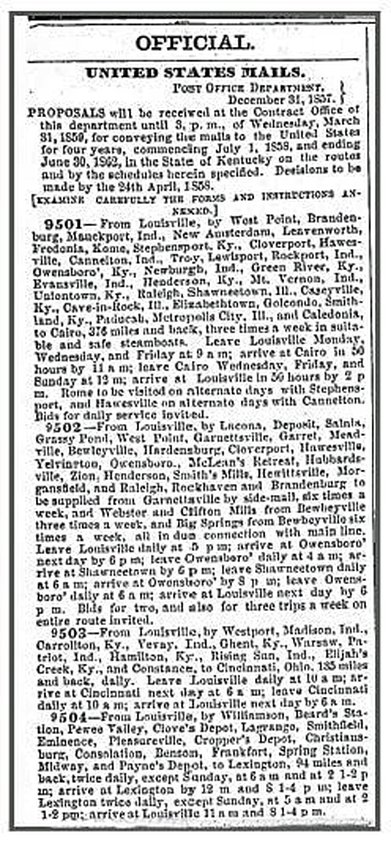 Railroad mail delivery schedule requested by the U.S. Post Office in 1857
Railroad mail delivery schedule requested by the U.S. Post Office in 1857
According to the Smithsonian Institution's National Postage Museum, prior to the Civil War, trains had to stop or slow to a crawl to deliver the mail at cities and towns along their routes. After the war, several new inventions revolutionized the Mail By Rail system, allowing trains to deliver and pick up "mail-on-the-fly" without stopping or slowing down as they chugged their way across the nation:
Incoming mail was simply kicked out the mail car door with enough force to ensure it wouldn’t be sucked up in the train’s wake.
The entire process required great skill on the part of the Railway Mail Service clerks staffing the mail cars. If the mail-bag catcher was raised too soon, it could hit telegraph poles, switch targets or semaphores. Too late, and the clerk who missed the exchange would receive five demerits. Mailbags that weren't kicked out hard enough could become trapped beneath the train's wheels and burst open, creating what the mail clerks referred to as a "snowstorm" of flying letters.
- The mail crane, positioned beside the track, where the outgoing mail was hung no more than 10 minutes before the mail train was scheduled to pass through;
- A canvas and leather catcher pouch that could hold up to 50 pounds of outgoing mail and was suspended from the crane’s arm by metal rings; and
- A steel arm known as a mail-bag catcher that was affixed to the mail car door and was manually deployed to grab the mail bag from the crane.
Incoming mail was simply kicked out the mail car door with enough force to ensure it wouldn’t be sucked up in the train’s wake.
The entire process required great skill on the part of the Railway Mail Service clerks staffing the mail cars. If the mail-bag catcher was raised too soon, it could hit telegraph poles, switch targets or semaphores. Too late, and the clerk who missed the exchange would receive five demerits. Mailbags that weren't kicked out hard enough could become trapped beneath the train's wheels and burst open, creating what the mail clerks referred to as a "snowstorm" of flying letters.
By the 1870s, the Railway Mail Service was the backbone of the U.S. postal system. More than 10,000 trains -- including some of the fastest passenger and express trains in the country -- eventually carried the mail. Iris Haskins noted in the November 1977 Call of the Pewee that Pewee Valley's mail was delivered mid-morning by the Pan-American as it made its way South. The Pan was the L&N's flagship passenger train for many years, and covered the 921 miles between Cincinnati, Oh., and New Orleans, La., from 1921 until 1971.
With cars and airlines luring travelers away from passenger trains in the 1940s, their numbers declined. In "Memories of Louisville" (Railfan & Railroad Magazine, February 1995) author Ron Flanary noted that the number of scheduled passenger trains in Louisville dropped from 60 per day in 1922 to just 13 by the early to mid-1960s. Seven of those were operated by the L&N and included the Pan-American, Numbers 98 and 99. Flanary reported, "By 1963, the Pan was running about 13 or 14 cars, including ample head-end traffic (editor's note: freight cars such as Railway Post Offices), coaches, a diner lounge and a Pullman...."
As passenger service declined, the Railway Mail Service declined with it. According to the Smithsonian Institution:
By 1948 there were only 794 RPO lines still in operation. In 1962, the number was down to 262. By 1971, only thirty trains were still using railway mail cranes in the United States. On May 1 of that year, AMTRAK (America, travel, and track) began operations and after just over a century of service, on–the–fly mail exchanges came to an end.
The Ward Mail-Bag Catcher
Matthews "Mackey" Fletcher was the last postmaster to hang a catcher pouch from the Pewee Valley's mail crane. Peweean Doris Stoess recalls she was hired by Fletcher as a part-time postal clerk in October 1968 and just a few weeks later, rail delivery was replaced by trucks -- more efficient, perhaps, but much less exciting to watch!
According to the August 1988 Call of the Pewee, Fletcher purchased the 800-pound mail crane after rail delivery stopped and stored it, along with a catcher pouch, on his Pewee Valley farm beneath a maple tree. After his death in 2004, it languished, forgotten, until the summer of 2016, when his grandson, Mike Thompson, rediscovered the crane and pouch and donated them to the city.
Allgeier Welding, Crestwood, Ky., sandblasted, repaired and painted the 19th century crane, which has been installed beside the caboose in Pewee Valley’s Town Square. The crane was originally located on the other side of the tracks.
According to the August 1988 Call of the Pewee, Fletcher purchased the 800-pound mail crane after rail delivery stopped and stored it, along with a catcher pouch, on his Pewee Valley farm beneath a maple tree. After his death in 2004, it languished, forgotten, until the summer of 2016, when his grandson, Mike Thompson, rediscovered the crane and pouch and donated them to the city.
Allgeier Welding, Crestwood, Ky., sandblasted, repaired and painted the 19th century crane, which has been installed beside the caboose in Pewee Valley’s Town Square. The crane was originally located on the other side of the tracks.
The catcher pouch is on display at the Pewee Valley Museum. The pouch was tied in the middle before it was hung on the mail crane to make it easy for the mail-bag catcher to grab. Small amounts of mail were placed in the lower half of the pouch. Large amounts were equally divided between the top and bottom.
According to Bob Widman, Chair of the Ohio Valley Railroad Historical Foundation, which operates the Lagrange Railroad Museum, the numbers on the bag denoted the month and year it was made. This one was manufactured in June 1956. Despite its age and the fact that it was stored in a barn for more then 40 years, the catcher pouch is in good condition. But then, catcher pouches had to be tough to withstand the stress of being snatched by a fast-moving train!
According to Bob Widman, Chair of the Ohio Valley Railroad Historical Foundation, which operates the Lagrange Railroad Museum, the numbers on the bag denoted the month and year it was made. This one was manufactured in June 1956. Despite its age and the fact that it was stored in a barn for more then 40 years, the catcher pouch is in good condition. But then, catcher pouches had to be tough to withstand the stress of being snatched by a fast-moving train!
Restoring the Mail Crane: The Story in Photos by Donna Russell
Celebrating Pewee Valley's Mail By Rail Heritage: October 22, 2016
Special Cancellation and Commemorative Post Card
|
Immediately after the ceremony, Pewee Valley Postmaster Andrea L. Braden and a group of current and retired postal workers offered a special commemorative Mail By Rail Station cancellation and post card at Town Hall.
The cancellation featured the caboose, Pewee Valley fencing and the mail crane. The postcard featured a photo by turn-of-the-20th-century Pewee Valley photographer Kate Matthews showing the "Beaten path to the Post Office," when it was located on Central Avenue. Both were designed by Pewee Valley artist and historical society member Shelley Schippert, who also designed the posters, invitations and programs. “It’s a tradition to have special cancellations designed by local artists,” Braden explained. |

Shirley Temple holds special meaning for Pewee Valley. The child actor played the part of Little Colonel Lloyd Sherman in the 1935 Fox Film classic, “The Little Colonel.” The movie was based on an 1895 novel by author Annie Fellows Johnston, who drew her inspiration from real people and real places in Pewee Valley. The stamp shown is from the Legends of Hollywood series and was released on April 18, 2016.
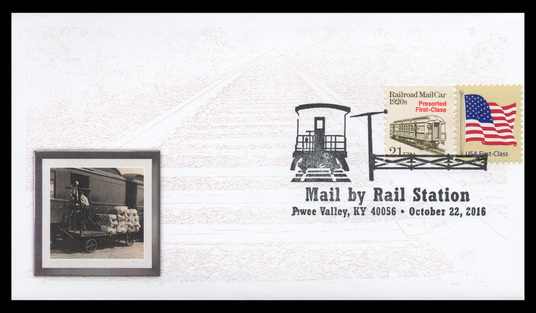
Postal artist Joshua McGee, owner of @McGeekiest Cachets in Pasadena, Cal., turned the Mail by Rail Station cancellation into five limited edition covers and offered them for sale on eBay for $5.98. His description is below:
Nothing stayed these couriers from their appointed tracks
A railway post office (RPO) was a railroad car operated to sort mail en route to a destination. Beginning in 1862, RPOs sped mail around the country, improving logistics and decreasing delivery time, finally ceasing operation in 1977.
These covers by @McGeekiest Cachets feature a detail of a black and white photograph from 1925 (held by the National Postal Museum in Washington, D.C.) surrounded by a digital frame and drop shadow. The background is a line extraction of railroad tracks stretching into the distance.
For postage, I used one tan First Class U.S. Flag sheet single (Scott #4129) and one Railroad Mail Car single from the Transportation Coils series (Scott #2265). They are postmarked with a "Mail by Rail Station" pictorial postmark from Pewee Valley, Kentucky, 40056 dated October 22, 2016.
Nothing stayed these couriers from their appointed tracks
A railway post office (RPO) was a railroad car operated to sort mail en route to a destination. Beginning in 1862, RPOs sped mail around the country, improving logistics and decreasing delivery time, finally ceasing operation in 1977.
These covers by @McGeekiest Cachets feature a detail of a black and white photograph from 1925 (held by the National Postal Museum in Washington, D.C.) surrounded by a digital frame and drop shadow. The background is a line extraction of railroad tracks stretching into the distance.
For postage, I used one tan First Class U.S. Flag sheet single (Scott #4129) and one Railroad Mail Car single from the Transportation Coils series (Scott #2265). They are postmarked with a "Mail by Rail Station" pictorial postmark from Pewee Valley, Kentucky, 40056 dated October 22, 2016.
Oldham County Channel 25 Coverage of the Mail Crane Dedication
Related Links





